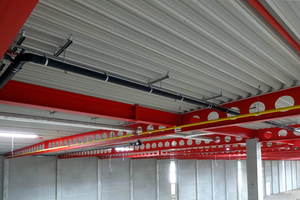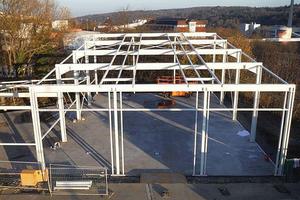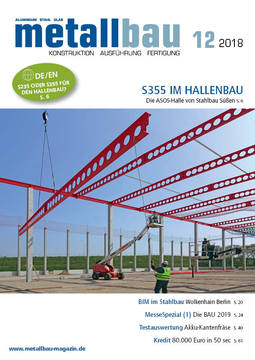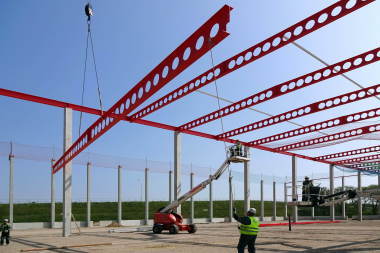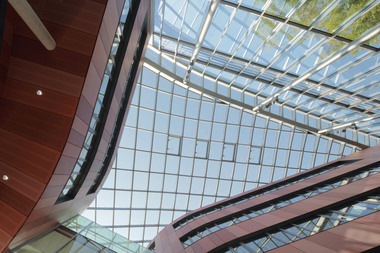Steel grades for building of halls
S235 or S355 rolled sections?“It would make things much easier if S235 rolled sections were completely withdrawn from the market and offered as S355 and S460M instead,” thinks Bernhard von Mühlenen, the Swiss head of steel construction at Senn AG. In Germany, S235 is often still used for commercial and industrial construction, says contractor Egon Haist: “We often use S355 for halls when price is a factor.”
Stahlbau Haist in Baiersbronn-Mitteltal has its own structural analysis and design office. If the company issues a tender with structural analysis, for example for a turnkey hall, it usually uses S355 rolled sections. Compared to S235, the material consumption is significantly reduced. “S355 involves more work in the workshop because we preheat the sections before welding, but it still works out cheaper,” explains Egon Haist. For the exterior constructors who are next to work on the construction, the higher strength grade makes things a little awkward: they can use self-tapping screws on S235 but not on S355. “Pre-drilling makes mounting more time-consuming.” Nevertheless, the use of S355 speaks for itself and metal construction expert Haist is surprised that many architects and structural engineers don’t use S355 when issuing hall construction tenders. “If the tender specifies S235, we will build the hall using this type of steel. „If Haist were to go against the tender and use S355, his structural analysis office would have to run a new analysis. “We don’t do this because of the additional cost.” The company generates around 60 percent of its annual turnover from commercial and industrial construction and general steel construction.
Structural analysis and steel grades
“The structural conditions of the building are the determining factor when it comes to choosing the steel grade”, says Rudolf Rauch, from Austria. For decades, he worked for voestalpine as head of hot-rolled steel strip welding in the company’s Research & Development department. “If the structural analysis allows, the use of S355 makes sense and, in many cases, is an economical solution, since the wall thicknesses and the weight of the construction are reduced and the often-ignored cost of the welding work can be significantly reduced thanks to smaller weld cross sections.”He goes on to clarify: “However, I would recommend the thermomechanically rolled steel grades S355M/ML or S460M/ML as per EN 10025-4, and not the general structural steel S355Jx as per EN 10025-2, as a substitute for S235Jx.”
Pre-heating not always used
Experience has shown that, in practice, M steels up to steel grade S460M/ML have a carbon content of C ≤ 0.1%. At ≤ 0.1% carbon content, hardening in weld seams is ≤ 380 HV10, even under unfavourable conditions. Problems with the upper hardness limit (hardness ≤ 380 HV10) for cutting and welding processes specified in EN 1090-2 (Technical Requirements for Steel Structures) are therefore not to be expected, as Rauch points out.
Preheating before welding is not required for manual metal arc or MAG welding processes if standard filler materials are used and the handling instructions specified by the supplier and component temperatures ≥ RT for up to 60 (90) mm sheet thickness are adhered to. In terms of carbon content, M steels are similar to S235Jx.
S355 M grades very easy to weld
The M steel grades are offered by all reputable rolled section manufacturers, thanks to their “excellent suitability for welding”. Rauch explains: “Since these M steels get their strength mainly from the hardening mechanism of grain refinement during the thermomechanical rolling process, their alloy content is very low.” The carbon equivalent (CEV as per EN 1011-2) of M steels is lower than the CEV of S355Jx (CEV ≤ 0.47 for nominal thicknesses >30 mm to ≤ 40 mm) and not significantly higher than the default value for S235Jx (CEV ≤ 0.35 for nominal thicknesses > 30 mm to ≤ 40 mm) due to the very fine microstructure of these steels with regard to the normative CEV upper limit for steel grade S355M (CEV ≤ 0.39 for nominal thicknesses ≤ 40 mm). Experience shows, however, that steel producers of M steels made using the latest technology offer CEV values ≤ 0.26–0.27 for steels up to S460. In particular, the normative restriction of the carbon (C) content (Cmax = 0.24 for S355J0-K2 and Cmax = 0.16 for S355M/ML) must be observed. These values determine both hardening and the preheating temperature, which is determined in accordance with the methods defined in EN 1011-2.
S355Jx as per EN 10025-2
Rauch advises companies that prefer S355Jx steel grades as per EN 10025-2 to use micro-alloyed fine grain structural steels with the lowest possible CEV instead. “The CEV of such micro-alloyed steels is always lower compared with standard S355Jx steels, because they have been developed to be easier to weld.”
The steel expert stresses that S355 rolled sections don’t have to be preheated per se and that this grade is “not actually difficult” for an experienced steel constructor to work with. “And neither are fine grain structural steels and S460”, he adds.
Information gaps in the market
Dr.-Eng. Dennis Rademacher, SFI/IWE, of ArcelorMittal Europe – Long Products, thinks it’s a shame that Rauch’s expertise and advice has not yet reached a wider audience on the German-speaking market. His main argument for using S355: the additional costs for S355 rolled sections compared with S235 are more than offset by average material savings of up to 20 percent. In other words, even if the required rolled section is reduced by only one section level, it’s more economical to use S355 than S235. There would also be additional cost savings in production, due to lower weld thicknesses, for example. In addition, larger spans can be achieved with the higher-strength beams.
Krings & Sieger’s experiences
Commercial, industrial and steel construction company Krings & Sieger is based in Düren and employs 30 people. On the construction site, employees spend about half of their time welding. This ensures that every welder gets enough experience. “All our welding specialists can work with S355, even if it makes up only around ten per cent of the rolled sections,” so Heinz Jörres. The reason: participants on the welding course learn both procedures. On the other hand, the Düren-based company rejects orders with S460, “because they are requested only every five years”.
Some contractors are not yet aware that DIN EN ISO 9606-1 now regulates the validity of the welder test according to the filler material used and no longer according to the base material used. Consequently, the test now applies for S235, S355 and S460.
The welding supervisor and material testing expert suspects that today’s reservations about S355 originate from the 1980s. Jörres recalls that around 40 years ago, cracks and fractures appeared when these rolled sections were used in ship and bridge building. “The problem at the time wasn’t the steel itself, but how it was worked,” Jörres clarifies. Today, however, S355 is used as standard in bridge construction. Nevertheless, he believes that S355 steel, formerly called St52, still hasn’t shaken off its bad image. The welding specialist knows that for certain types of S355 the sections must be tempered before welding because of the carbon equivalent value of the alloying elements in the steel, so that the material fully retains its ductile properties. If the steel to be welded is heated in the area of the joint, the risk of the microstructure hardening is reduced. This can happen if the weld cools down too quickly. The preheating temperature, which is intended to prevent cold cracking later on, depends essentially on the thickness of the sheets, the heat dissipation, the alloy and the heat input during welding.
Cold cracking in S355
One of the biggest problems when welding high-strength fine grain steels like S355 is cold cracking, according to chartered engineer and SFI Martin Erl, Managing Director of Erl Schweißen + Schneiden in Landau/Isar. “In general, the susceptibility of micro-alloyed fine grain steels to cold cracking is low. However, in the presence of higher carbon equivalent values, cold cracking may occur in the heat-affected zone (HAZ).” The cold cracking behaviour of welded joints is mainly dependent on the chemical composition, the thickness of the workpiece in the weld area, the hydrogen content of the weld metal, the heat input during welding, the residual stress level of the construction and the preheat or interpass temperature.
“The hydrogen in the weld metal and in the heat-affected zone essentially originates from hydrogen-containing components of the filler materials and welding consumables”, says Erl. Hydrogen can also get into the weld metal through moisture present on the workpieces, e.g. condensation. The cooling after preheating and welding of the weld area gives the hydrogen the chance to recombine. Effusion can be accelerated if, instead of immediately being cooled down, the weld is kept at a temperature of 150–200°C for 1–2 hours.
Especially with thick-walled workpieces, experts recommend welding the joint under heat. In the event of unavoidable interruptions, cool down slowly and preheat again. With multi-layer welding, on the other hand, the interpass temperature, rather than the preheating temperature, becomes more important. “There’s no need for preheating before welding the first bead”, says Erl, “if the subsequent bead is welded in the heat of the first bead so that the interpass temperature doesn’t drop below the preheating temperature needed to prevent cold cracking”.
Recommendations of chartered engineer Dennis Rademacher SFI/IWE for welding S355M/ML with and without preheating
If the general requirements for welding steels as per DIN EN 1011-2 are observed, thermomechanical fine grain structural steels are just as or even better suited to welding than unalloyed structural steels. Due to their particular purity there is no or only very low susceptibility to lamellar fractures.
As with any steel, it is recommended to preheat any areas to be cut to 50°C if the product is wet or the temperature is below freezing. Excessive heat input should be avoided, as this may result in less favourable properties in the heat-affected zone (HAZ).
The weld area must be cleaned before starting the subsequent welding. Slag, scale and rust should be removed by brushing, grinding, or ideally by blasting.
Pre-heating not always used
In terms of manufacturing technology, thicker structural steels in particular must usually be preheated before welding. The preheating and interpass temperatures can be controlled using temperature measuring pins, magnetic thermometers, digital temperature measuring instruments or pyrometers. Drying or preheating must also be used to ensure that the weld area is moisture-free.
When using specially finished hot-rolled sections, preheating can generally be dispensed with completely. Using the QST (quenching and self-tempering) process at the end of the rolling mill produces a finer-grained microstructure with particularly high levels of strength and ductility but also an extremely low carbon equivalent value. This is done by cooling the section surface with a water jet. Because the core is not cooled, the section reheats the surface from within (self-tempering).
Steels of this special grade, such as those produced by ArcelorMittal under the brand name Histar, can be used with a European Technical Assessment (ETA). ETA -10/0156 [4], for example, regulates product properties in addition to DIN EN 10025-4 and provides additional instructions for working without preheating.

